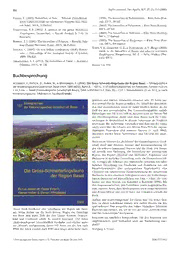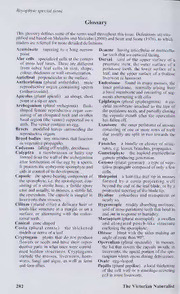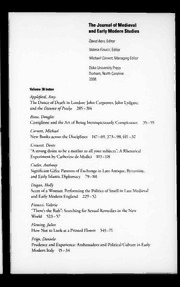
Client-Centred Practice in Occupational Therapy. A Guide to Implementation PDF
Preview Client-Centred Practice in Occupational Therapy. A Guide to Implementation
© 1999, Elsevier Limited. © 2006, Elsevier Limited. All rights reserved. No part of this publication may be reproduced, stored in a retrieval system, or transmitted in any form or by any means, electronic, mechanical, photocopying, recording or otherwise, without the prior permission of the Publishers. Permissions may be sought directly from Elsevier’s Health Sciences Rights Department, 1600 John F. Kennedy Boulevard, Suite 1800, Philadelphia, PA 19103-2899, USA: phone: (+1) 215 239 3804; fax: (+1) 215 239 3805; or, e-mail: healthpermissions@elsevier.com. You may also complete your request on-line via the Elsevier homepage (http://www.elsevier.com), by selecting ‘Support and contact’ and then ‘Copyright and Permission’. First edition 1999 Reprinted 2005 ISBN 0 443 10171 X British Library Cataloguing in Publication Data A catalogue record for this book is available from the British Library Library of Congress Cataloging in Publication Data A catalog record for this book is available from the Library of Congress Note Knowledge and best practice in this fi eld are constantly changing. As new research and experience broaden our knowledge, changes in practice, treatment and drug therapy may become necessary or appropriate. Readers are advised to check the most current information provided (i) on procedures featured or (ii) by the manufacturer of each product to be administered, to verify the recommended dose or formula, the method and duration of administration, and contraindications. It is the responsibility of the practitioner, relying on their own experience and knowledge of the patient, to make diagnoses, to determine dosages and the best treatment for each individual patient, and to take all appropriate safety precautions. To the fullest extent of the law, neither the publisher nor the editor assumes any liability for any injury and/or damage. The Publisher Working together to grow libraries in developing countries www.elsevier.com | www.bookaid.org | www.sabre.org The publisher’s policyis to use paper manufactured from sustainable forests Printed in China PR-F10171.indd iv 2/1/06 12:26:26 PM Dedication To Marjorie and Clarence for all they taught me about love and my rural roots To my colleagues and clients who have taught me the value of pursuing my passion for client-centred practice My sincere thanks to all the occupational therapists who successfully apply a client-centred approach. PR-F10171.indd v 2/1/06 12:26:26 PM Chapter 1 Overview of client-centred practice ix Contributors Debra Cameron PhD OT Reg (Ont) Assistant Professor, Department of Occupational Therapy, University of Toronto, Toronto, Ontario, Canada Working with children and their families for over 20 years has inspired Deb’s ongoing interest in the benefi ts and challenges of providing client- centred practice in paediatrics. Anne Carswell PhD FCAOT OT Reg (NS) Associate Professor, School of Occupational Therapy, Dalhousie University, Halifax, Nova Scotia, Canada Anne is one of the six co-authors of the Canadian Occupational Perform- ance Measure. She has practised client-centred occupational therapy for over 40 years and has conducted research in this area with older adults who have dementia and their families. Joanne Valiant Cook PhD Associate Professor, School of Occupational Therapy, The University of Western Ontario, London, Ontario, Canada In her role as associate professor, Joanne shares her expertise regarding psychosocial rehabilitation, client-centred care, qualitative research and other subjects with a particular focus on helping students understand the client’s experience of mental illness. Joanne’s clinical, consulting and research experiences have been primarily in the fi eld of mental health and illness with a particular focus on innovations in service programmes. Her research strategies and designs have always been within the qualitative paradigm of inquiry. Deborah Corring PhD OT Reg (Ont) Program Director, Regional Mental Health Care St Thomas, St Joseph’s Health Care London, Ontario, Canada Deb is the Program Director of a large clinical programme that has both inpatient and outpatient components. The programme operates under a psychosocial rehabilitation philosophy with a recovery focus. Deb has worked in mental health for 33 years as a clinician, an administrator and as a qualitative researcher. Her past and current research has focused on PR-F10171.indd ix 2/1/06 12:26:27 PM x Contributors articulating the client perspective concerning several issues including quality of life, satisfaction with services received, etc. Marie Gage MSc BSc(OT) OT(C) Collective Wisdom Management, Haliburton, Ontario, Canada Marie teaches client-centred care planning to interdisciplinary care teams that are interested in integrating their care. Marie also provides direct clinical services to clients, with a variety of physical diagnoses, in their home. Sandra Jean Graham Hobson MAEd LLD OT Reg (Ont) Associate Professor, School of Occupational Therapy, The University of Western Ontario, London, Ontario, Canada Sandra has worked with older adults, many suffering from cognitive impair- ment, and young adults with acquired brain injury. She has taught on the topic of client-centred practice with both of these populations. Mary Ann McColl PhD Associate Director for Research, Centre for Health Services & Policy Research, and Professor in the Departments of Community Health & Epidemiology and Rehabilitation Therapy, Queen’s University, Kingston, Ontario, Canada In addition to being co-author of the COPM, she has written a number of books, including Introduction to Disability, Theoretical Basis of Occupational Therapy and Spirituality and Occupational Therapy. Davina Parker MSc Dip COT Head of Occupational Therapy, University Hospital Birmingham NHS Foundation Trust, Birmingham, UK With her experience of implementing client-centred practice in clinical set- tings, Davina’s interest lies in the application of the COPM and the challenges that face the therapist. Nancy Pollock MSc OT Reg (Ont) Associate Clinical Professor, School of Rehabilitation Science, McMaster University, Hamilton, Ontario, Canada Nancy is a researcher with the CanChild Centre for Childhood Disability Research where she studies family-centred practice. She is one of the co- authors of the COPM and applies these concepts in her paediatric clinical practice with children, families and teachers. Debra Stewart MSc OT Reg (Ont) Assistant Dean, Occupational Therapy Programme, School of Rehabilitation Science, McMaster University, Hamilton, Ontario, Canada Debra’s clinical and research interests are in the fi eld of paediatrics. She is a co-investigator with CanChild Centre for Childhood Disability Research and is involved in numerous projects related to adolescence and the transition to adulthood for youths with disabilities. Thelma Sumsion, PhD MEd BSc(OT) OT Reg (Ont) FCAOT Director, School of Occupational Therapy, The University of Western Ontario, London, Ontario, Canada Thelma has been interested in client-centred practice since the 1980s and in 2002 she completed her PhD studies in England related to defi ning this concept. PR-F10171.indd x 2/1/06 12:26:27 PM Chapter 1 Overview of client-centred practice xi Foreword Christine Craik The fi rst edition of this book was a milestone in client-centred practice, bringing together in a clear and logical way the philosophy of client- centred practice, the academic underpinning which contributes to its development and – probably most important for therapists – the practical application of the philosophy. The editor assembled a distinguished group of authors with the knowledge and credentials to help us to understand the concepts and implement them. The book has assisted occupational therapists throughout the world to put into effect the essence of the profession: the collaboration or partner- ship between the client and the therapist working together to achieve the client’s goals. Although this philosophy is central to occupational therapy, understanding its true meaning and implementing it have always been challenging. Most occupational therapists claim to work within a client- centred model and this book has enabled us to do this more effectively. For the second edition, the same groups of authors have updated and expanded their chapters and there is now a new chapter on the important area of paediatrics. Case studies are used to illustrate client-centred prac- tice in a meaningful way. The concept of client-centred practice has been afforded greater or lesser recognition at different times during the history of the profession, but it is clearly at the heart of occupational therapy. Currently, the need to justify intervention according to a developing evidence base, to provide value for money and to reduce complex interventions to a series of simple protocols all represent challenges to working in a client-centred way. If we strive to uphold the philosophy and reality of client-centred practice, this second edition provides the inspiration and guidance to do so. My fi rst question about this second edition was to ask if the poignant story of Nick was to be included. Yes, it is still here. And who, having read this exemplar of client-centred practice, could deny the justifi cation of providing the red wheelchair? Christine Craik 2005 PR-F10171.indd xi 2/1/06 12:26:27 PM xii CLIENT-CENTRED PRACTICE IN OCCUPATIONAL THERAPY Foreword John Glossop I am an ex-teacher and in 1983 I was disabled by a subarachnoid haemor- rhage. I am a wheelchair user and a partially sighted hemiplegic. I am married, have three children, a dog, a cat and two goldfi sh. I now have three grand- children who have grown up treating disability with the same irreverence that I do. I am unique, I am not a collection of symptoms and physical problems, I am more than the sum of my disabilities. My goals may not be your goals; things which you consider necessary to your very existence may be of little or no importance to me. Before my brain haemorrhage I sailed competitively. An outdoor pursuits centre went to great efforts to arrange for me to sail in a trimaran specially adapted for the disabled. It took hours to rig the boat and winch me aboard. Sailing must incorporate some degree of danger or adrenalin rush but this was safe to the point of boredom and I have never sailed since. I have to live with my disabilities 24 hours a day; I am disabled at weekends, on bank holidays and even on Christmas Day. Crises do not occur to suit professionals. Also, I am not a saint! I do things which I know are bad for me and enjoy doing them. I am lazy and therapies are more likely to be effec- tive when incorporated into my lifestyle. The therapeutic use of a heavy beer glass should not be ignored and my coordination has been greatly improved by repetitive action of fi lling and lighting my pipe, though the close proximity of a fi re extinguisher is advisable. I am a member of a family and their needs must be taken into considera- tion. A bathroom full of ironwork is fi ne as long as there’s room for daughters, who spend half a lifetime in there with face packs and hair dye; don’t offer me a single bed no matter how medically sound. I am a husband and father who happens to be disabled. I had the pleasure of meeting Thelma Sumsion whilst speaking at an OT conference and found that we had many ideas in common. I am a strong proponent of client-centred practice and hope that in future this common sense approach crosses into other disciplines. John Glossop 2006 PR-F10171.indd xii 2/1/06 12:26:27 PM Chapter 1 Overview of client-centred practice xiii Preface My interest in client-centred practice began in the early 1980s when I chaired the fi rst in a series of working groups organised by the Canadian Association of Occupational Therapists. This work continued for many years and resulted in several publications, many of which are discussed in this text, designed to assist occupational therapists with the implementa- tion of client-centred practice. The members of these groups were inspi- rational and we all owe a great deal to their commitment to client-centred practice. Over the intervening years Canadian therapists have struggled with many challenges related to the implementation of client-centred practice. This text aims to address many of these challenges by combining infor- mation about the theoretical and practical aspects of this approach to practice. The contributing authors were chosen because of their interest and expertise in client-centred practice as well as their varied experiences in working with a range of client groups. I relocated to England in 1996 and quickly became aware of the inter- est in this approach that therapists throughout the United Kingdom shared with their Canadian colleagues. This shared awareness gave rise to the fi rst edition of this book and the invitation to authors from both Canada and England to share their expertise. I returned to Canada in 2002 and the dialogues that continued in both countries supported the importance of this second edition. It continues to be my hope that thera- pists in many countries will fi nd information in this book that will enable them to remove the barriers to the implementation of client-centred practice and to strengthen their commitment to this approach for the benefi t of their clients. T. Sumsion 2006 PR-F10171.indd xiii 2/1/06 12:26:27 PM 1 1 Chapter Overview of client-centred practice T. Sumsion CHAPTER CONTENTS Emerging importance of client-centred Outcomes and effectiveness 8 practice 1 Model of Occupational Performance 9 Models of client-centred practice 3 Relationship of the Model of Occupational Defi nitions 5 Performance to other approaches 15 Client-centred programmes 7 Conclusion 16 This chapter presents the core concepts of client-centred practice that must be clearly understood before successful implementation is achieved. A variety of models and defi nitions is discussed with a focus on the Canadian Model of Occupational Performance (CMOP). Clinical examples are provided in the discussion of the components of the CMOP, and the relationship of this approach to other approaches used by occupational therapists is briefl y outlined. EMERGING IMPORTANCE OF CLIENT-CENTRED PRACTICE Client-centred practice is now an important approach to intervention in many areas of occupational therapy practice across several continents. The reasons for this reality are complex and are based on the realisation that the client is the most important component of any intervention. Occu- pational therapists’ values and beliefs support a client-centred approach that embraces the client’s active involvement (Townsend & Wilcock 2004). However, in the daily work of a therapist it often seems that the budget, the current approach to management or staff shortages prevail and dictate how work is performed (Nelligan et al 2002). Inclinations to succumb to these forces must be overcome and a balance achieved that places the client fi rmly in the position of receiving the full potential of engaging in a productive partnership with the therapist. Health promotion, which emerged as an important concept within health care in the 1980s, laid the foundation for clients to be involved in Ch001-F10171.indd 1 2/1/06 2:03:04 PM 2 CLIENT-CENTRED PRACTICE IN OCCUPATIONAL THERAPY health care and to be responsible for their own health. Health promotion, as defi ned by the World Health Organization, is ‘the process of enabling people to increase control over and to improve their health’ (WHO 1986, p 1). The recognition of the importance of these concepts has facilitated their integration into many programmes that fully support consumer awareness. Further developments in the 1990s and beyond have seen the emergence of consumer-led and self-help groups which strive to meet needs outside the realm of professional involvement. These are truly client-centred programmes. Consumer rights, human rights and the tech- nological revolution have also hastened the development of client-centred practice (Gage 1994, Law et al 1995). Therapists in the United Kingdom are aware that the College of Occu- pational Therapists supports the client-centred approach to intervention by encouraging the involvement of the client as a partner in all stages of the therapeutic process and stating within the Code of Ethics and Profes- sional Conduct that services should be client-centred and needs led. This document also reminds therapists that clients are unique and bring their own perspective to the occupational therapy process (College of Occupa- tional Therapists 2000). The Code of Ethics of the Canadian Association of Occupational Therapists (CAOT) also advises members to demonstrate respect for and appreciate the particular needs of the client (CAOT 1996). It is important that therapists understand the implications of these state- ments and have the necessary information to implement this approach. Universities are also acknowledging the need to change the way future therapists and doctors are educated. The medical school at a major Cana- dian university has adopted a patient-centred method as the focus of the curriculum. This method recognises that the patient has a disease but also an illness experience that is unique to that individual. The student-centred programme introduces a case at the beginning of each week. Students interview the patient, discuss issues and spend the week learning what they need to know to treat the patient (Western Alumni 1997). Through- out this process the focus is on the patient, not the therapist. The above examples might lead to the conclusion that client-centred practice is fully supported by all health professionals. However, as will be outlined in this book, there are many aspects of this approach that provide a considerable challenge to the fundamental beliefs of many therapists. There continues to be a struggle among health professionals concerning the confl ict that arises between the client’s role in decision-making and the values of the patient and the professional (Emmanuel & Emmanuel 1992). All of these issues provided the impetus for this book, which attempts to facilitate the implementation of client-centred practice. It has been written for all therapists whether they work as clinicians, managers, educa- tors or consultants, or are enrolled in an educational programme to become a clinician. The information is also relevant to therapists in all work settings, including hospitals, communities, schools, universities and industries. The focus is both theoretical and practical with an emphasis on providing solutions to some of the more challenging aspects of implementation. Ch001-F10171.indd 2 2/1/06 2:03:05 PM Overview of client-centred practice 3 The book begins with an overview of a variety of models of client- centred practice with a focus on the Canadian Model of Occupational Performance, which was designed by and for occupational therapists. Subsequent chapters address the client-centred approach, environmental considerations and implementation issues. A manager provides detailed information about how to implement a client-centred approach within a clinical department. The next series of chapters addresses implementation issues with specifi c client groups, including those with cognitive impair- ments, the elderly, clients with mental health and physical problems, and children. The fi nal chapter provides information about the Canadian Occupational Performance Measure, which is an appropriate outcome measure to conclude the discussion. All the contributing authors believe in client-centred practice and share the wish that ‘client centred’ will be more than just the latest catch phrase (Sherr Klein 1997). This is a book about client-centred practice and therefore client is the preferred term when referring to the person or persons with whom the occupational therapist interacts. In subsequent chapters the term client is used consistently. However, in this chapter the term patient is used occasionally if that was the term preferred by the authors whose work is being discussed. Both male and female pronouns are used to refer to clients and therapists throughout this book with no preference to either sex intended. MODELS OF CLIENT-CENTRED PRACTICE Client-centred practice is not unique to occupational therapy. Several models that focus on the client have been proposed by other disciplines. The Tidal Model is one example and encompasses four main components: active collaboration with the client to plan and deliver care, empower- ment, integration of services, and resolution of problems (Stevenson 2001). A client-centred approach has also been developed to address the process of prescriptions for medication. This process clearly operates around the client as the central feature and includes knowledge of the client, the drug regimen and side effects as well as client advocacy and a review of the process (Anonymous 2001). Levenstein et al (1986) focus on the potential for patients and doctors to have different agendas. The doctor’s agenda is to assign a differential diagnosis through history-taking, physical examination and laboratory investigation. The patient brings expectations, feelings and fears, and seeks to understand the illness experience. In a patient-centred approach the doctor’s aim is to ascertain the patient’s agenda and to reconcile this with his or her own. This reconciliation leads to integration and a positive outcome for both the client and the physician. Integration is facilitated through the consideration of the six interacting components of the patient-centred process that incorporate both knowl- edge and skill (Stewart et al 2003). These components are: Ch001-F10171.indd 3 2/1/06 2:03:05 PM
The list of books you might like

Atomic Habits James Clear

Can’t Hurt Me: Master Your Mind and Defy the Odds

Do Epic Shit

The Silent Patient

Phylogenetic, habitat, and behavioural aspects of possum behaviour in European lepidoptera

BWT AQA basic

Ferroic materials for smart systems from fundamentals to device applications

Prairie Schooner 2006: Vol 80 Index

CAPÍTULO XI PROBLEMÁTICA ACTUAL DE LA CONT AMINAC¡ÓN DE LAS AGUAS ...

TCPS 1262-2549: Jointed Paper Grass

By Aaron Grothe NEbraskaCERT

DTIC ADP023953: Space Power for War Fighters

Poetry and Painting in Song China: The Subtle Art of Dissent

Talon, The

Buchbesprechung: Die Gross-Schmetterlingsfauna der Region Basel

NASA Technical Reports Server (NTRS) 20060051773: A Low Cost Spacecraft Architecture for Robotic Lunar Exploration Projects

Glossary

Polar Bear: 2006

Katharine Lauderdale vol 1 of 2 by F Marion Crawford

ERIC ED362642: Developments in the Curriculum for the Swedish MSc Programme in Agriculture.




